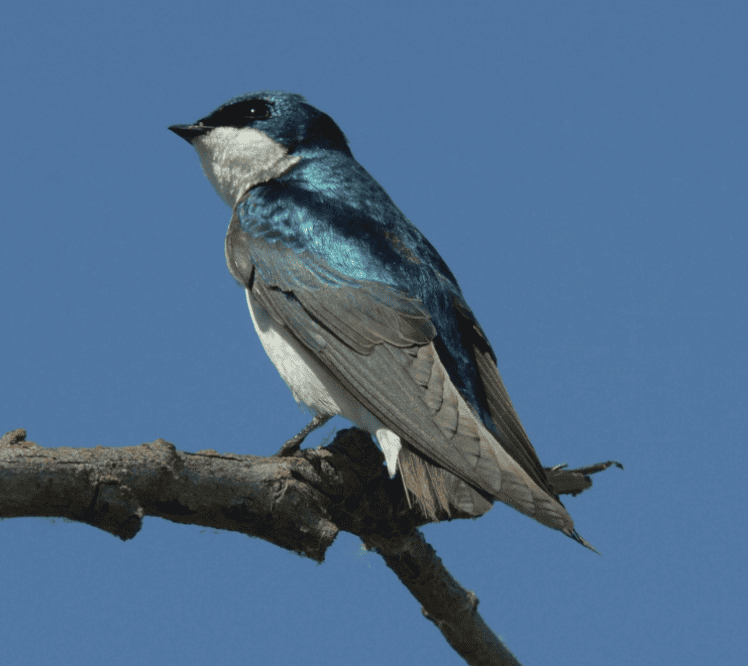Community Science in an Urban Park
By Noreen Weeden
The Bison Paddock in Golden Gate Park sounds like an unlikely site for a community science project, but indeed it is. Golden Gate Bird Alliance (GGBA) volunteers and the San Francisco Park and Recreation Department (SFRPD) have partnered on a project for Tree Swallows and Western Bluebirds. Since 2009, GGBA and SFRPD have been supporting habitat for native birds at the Bison Paddock. Over the last 10 years, this project has presented opportunities and challenges.
The Bison Paddock is the largest local meadow habitat in the park with nearby freshwater (Chain of Lakes). Every spring the park blooms with biodiversity, where native plants attract insects, which in turn brings birds back to the area.
Our story begins with Tyler Lorillo, a Boy Scout who was interested in local, nesting birds and contacted GGBA. After getting in touch GGBA, he proposed to work with 6 other scouts to build and install nest boxes. The GGBA connected Tyler with Gloria Koch-Gonzales, then Manager of Golden Gate Park, and Josiah Clark of Habitat Potential regarding the Bison Paddock site. At the time, 2 Western Bluebird and 6 Tree Swallow nest boxes were recommended.
Under Cornell University’s Lab of Ornithology, Tree Swallows and Western Bluebirds are identified as Western Focal bird species, meaning there is a lack of information regarding these birds. NestWatch is a nationwide monitoring program designed to track status and trends in the reproductive biology of birds. Volunteers in many places record important data including when nesting occurs, number of eggs laid versus the number of eggs hatched, and how many hatchlings survive. Their database is intended to be used to study the current condition of breeding bird populations and how they may be changing over time as a result of climate change, habitat degradation and loss, expansion of urban areas, and the introduction of non-native plants and animals. Cornell’s NestWatch program allows community scientists the opportunity to learn how to monitor and collect data. Throughout the 10-year project, NestWatch’s data formatting has been used to monitor the Tree Swallows in the bison paddock.

Both Tree Swallows and Western Bluebirds nest in the cavities of decaying trees. In Golden Gate Park, and in other parts of the City dead and decaying trees are removed due to potential danger to the public or property. The consequence of this safety measure means that the cavity-nesting birds have fewer places to build a nest. Nest boxes can provide a suitable alternative for these species to build their nest, lay eggs, feed chicks, and fledge young. The nest box is designed to provide space for the Tree Swallow or Western Bluebird with a 1-1/2” entry, which is just right for the birds and prevents predators from access their clutch. The boxes are monitored from afar during the nesting season and opened only once, usually in October after most of the nesting birds have left.

From early April until the Summer Solstice in mid-July, Eileen and her crew of volunteers are hard at work, maintaining a keen eye on the nest boxes and their inhabitants. Observations are conducted only from the outside of paddock to maximize volunteer safety and minimize bison disturbance. GGBA, in collaboration with SFRPD and the SF Zoo, coordinate a date to temporarily move the bison out of the paddock each fall or winter. The boxes are opened individually by Ken Preston of the SFRPD, as volunteers stand by and wait eagerly to see what surprises a new year may bring. The contents of each box are removed, noted, and photographed in an effort to evaluate nest occupancy and nest success. Finally, each box is cleaned so it can house a pair of birds in the next nesting season.

Outside of the paddock, Eileen compiles data from the previous season with whatever findings come from opening the boxes to create an annual report that is sent to SFPRD and all volunteers involved in the project. Over the last 10 years, her reports have helped track some of the ongoing adjustments that have been made to the project. Some changes include: changing the height of the nest boxes, adding nest boxes at more successful areas, moving the boxes to prevent predator access (raccoon or skunk), and replacing boxes over time.
As of 2018, Esther Grady, a student at the time at University of San Francisco (USF), helped begin the analysis of all data collected over the last 10 years. Esther first contacted the GGBA to find a service project for her Conservation Biology course, but quickly took interest in the Tree Swallow nest box project. Esther enjoys working with data and wanted to better understand how the Tree Swallows were interacting with their environment. In the midst of finishing school and working two jobs, Esther put together a report with her findings. The result is a paper she titled Understanding Tree Swallow (Tachycineta bicolor) interaction with nest boxes in an urban park setting. She now has graduated from USF with a B.S. in Biology with an emphasis in Ecology and is still participating in the project. Of the project, Esther says that the results raise more questions rather than answering current questions. Spoken like a true scientist.
Esther and Eileen recently met to discuss goals and improvements to the project for next season, including improving data collection, the ability for trained volunteers to enter data in a central, digital location, evaluating the nest boxes by quadrant, and improving public knowledge on the project with an informational handout on the Tree Swallows and Western Bluebirds. This interest and dedication to community science in an urban park is inspiring.
Noreen Weeden is an avid birder and GGBA’s now retired Director of Volunteers. In her position, Noreen inspired our community for over 15 years. Her extraordinary accomplishments include the restoration of Pier 94, Lights Out for Bird Migration advocacy, and inspiring GGBA staff and volunteers alike to help birds.
